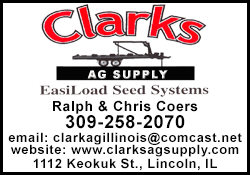 The real competition in farming is passive: Farmers are at the
mercy of the weather and the markets. Market prices are based on
the size of the harvest and the current availability of corn and
beans. If most producers in the country have a good harvest, the
price per bushel at harvest is low. What a Logan County farmer
hopes for is a high price and a good yield, but that is only
accomplished if farmers in other production areas don't fare as
well on yield because of regional weather conditions. The local
farmers aren't hoping other farmers will fail, but that is the
only way to win passively in the price-per-bushel game. The real competition in farming is passive: Farmers are at the
mercy of the weather and the markets. Market prices are based on
the size of the harvest and the current availability of corn and
beans. If most producers in the country have a good harvest, the
price per bushel at harvest is low. What a Logan County farmer
hopes for is a high price and a good yield, but that is only
accomplished if farmers in other production areas don't fare as
well on yield because of regional weather conditions. The local
farmers aren't hoping other farmers will fail, but that is the
only way to win passively in the price-per-bushel game.One of
the options to actively hedge is to put a portion of your crop
in storage at the local elevator. The elevator charges a price
to dry the grain to healthy storage levels and a fee per bushel
to store the grain, and the producer gets to choose the time to
sell. The downside to storing at the elevator is that you will
sell to that facility, and there can be a significant difference
in bid price between different co-ops on certain days.

Another active hedge is to store grain on your own farm in
your own storage bins. Exercising this option allows you to
capture carry in the market and expands your marketing
opportunities. With your own storage, you get to choose when to
sell and where to sell.
Looking at some of the bins constructed recently, on-farm
storage looks like a costly expenditure, but according to Tyler
Haning of Huffman Farm Supply Inc., most of their customers pay
for a bin in three to five years. In certain years, customers
can pay for a bin in less than one year. Put in those terms, the
on-farm storage option sounds like an affordable way to go.
In addition to being affordable, there are other options
on-farm storage brings a local producer. On-site drying is
cheaper than the elevator charges, and your own grain does not
have to be "shrunk" to 14 percent. Drying cost can be only
marginally lower, but many think it is much higher. This is not
true; normally individual farmers will dry for about 60 percent
of the elevator charge. This includes patronage checks or drying
cost refunds that some co-ops offer.
Haning says they have definitely seen a change in the drying
trend in last two to three years. Prior to 2009, the trend was
natural-air drying and not being overly concerned about capacity
or expansion.
Recently, continuous-flow dryers have become increasingly
popular. As capacity for on-farm storage rises, farmers are
producing more bushels, harvesting more efficiently and hauling
faster. This has increased the demand for on-farm systems to
perform in more of a "commercial" facility realm. With all these
variables taken into consideration, a continuous-flow dryer is
the most effective and efficient way to dry grain. Farm
operations are growing, and these on-site systems continue to
get larger.
Haning said, "This last year we had several customers put up
drying and storage systems, and they had never had either
before."
Commercial grain farming has become more of a business
instead of a way of life. Farmers are cutting costs and making
money by saving pennies where they can, while becoming more
efficient. Usually, it doesn't take long to notice the benefits
of on-site storage and drying facilities, especially on the
large scale.
On-farm storage allows farmers to operate longer and farm
more acres because with their own storage, they can run even
when the elevator isn't open. This also cuts down on time and
manpower because your employee isn't waiting in line at the
elevator.
[to top of second column] |

You won't find a lot of arguments against the benefits of on-farm
storage. Some producers are shocked at how much more profitable it
can be, and most agree it is more beneficial. It is just a matter of
the extra work and management, and if it suits their operation.
There are a few considerations a producer must make when deciding
about purchasing on-farm storage. The first is that there is more
work involved and more management. Bringing it to the elevator puts
the management of the grain in the hands of the elevator operator,
but on-farm storage means the farmer must maintain what is stored in
his own bins.
This means that the farmer should make a weekly check of the
contents of the bin, and that means climbing to the top to check.
Failure to check the health of the stored crop and the moisture
levels in the bin can cause the whole bin to go sour.
Another downside is that you handle the grain twice (this can
mean extra trucking cost), and many will say that it damages the
grain more. This is marginally true: It is damaged more, but not
significantly, as naysayers believe. And with newer conveying
equipment, the damage is almost completely negated.
Haning says the last advice they always give their customers is
to not just update or right-size for now, but leave room for
expansion in the future. Think several years down the road and give
yourself room to grow.

On-farm storage gives the local producer the ability to shape
their own economic outcome and, in turn, shape the entire industry
by withholding grain from the market when prices are low, thereby
driving prices up. The option to store a portion of your own crop in
your own storage can increase your long-term profitability and puts
you in charge.
[By JIM YOUNGQUIST with information from Tyler
Haning]
|